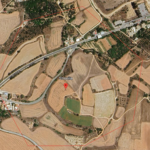My engagement with the course Sensing the Past: Intimacy and Heritage as an Ethical Practice has deeply influenced my approach to fieldwork. The very title—sensing the past—resonates with the core of my project. My research explores the resilience of living heritage in contested spaces, and this course has led me to consider how sensory experiences shape memory, identity, and belonging, and how those experiences can be preserved. Future generations should be able to experience cultural heritage, even when it has been lost or is at risk of disappearing, like in the case of Strovilia.
Engaging with Hamilakis’ (2014) work on sensory archaeology, a recommended reading from the course, has been particularly useful in shaping my understanding of how embodied experiences sustain cultural memory. He emphasizes that memory is not purely cognitive but deeply sensorial, embedded in tastes, sounds, and material interactions that anchor identity and belonging. This perspective aligns with my research in Strovilia, where the church and coffee shop once served as sensory-rich communal spaces, fostering cultural continuity.
Building on this, Hamilakis (2014) draws on Sutton’s (2001) concept of prospective memory, which explains how sensory experiences, particularly taste and smell, are not only triggers of the past but also tools for preserving memory into the future. During his fieldwork in Greece, Sutton observed how people encouraged him to ‘eat to remember,’ deliberately linking flavors, aromas, and rituals to memory so that later in life, those sensory experiences would evoke the place and people he had encountered. This idea suggests that sensory heritage is not only recalled but actively constructed, embedding itself in bodily experience and cultural transmission.
Hamilakis also engages with Seremetakis’ (1994) notion of commensality, which highlights the exchange of sensory memories and emotions through shared experiences, objects, and places. She argues that history, knowledge, and the senses intertwine within material culture, where a simple act like drinking coffee in a familiar space, becomes a sensory anchor for belonging and identity. These ideas are particularly relevant to living heritage in contested spaces, where physical sites may be lost, but the sensory imprints remain embedded in personal and collective memory. By integrating these concepts, I see living heritage not just as a collection of traditions but as an ongoing sensory and affective process. One that exists beyond physical presence and persists through embodied memory and social practice.
These insights will directly shape both my fieldwork and analysis, particularly through semi-structured interviews that incorporate memory mapping from the outset. I plan to begin each interview with a participatory memory mapping session, where participants will identify places of personal and communal significance. This approach ensures that key heritage sites are identified organically, allowing for a broader range of important spaces to emerge beyond the coffee shop and the church.
Through this process, I will explore sensory memory, asking participants to recall smells, flavors, and sounds that defined their experiences of these places. How did the taste and smell of coffee and freshly baked goods foster a sense of belonging? What were the familiar sounds of the village, and how have they changed over time? By embedding these sensory reflections within the mapping process, I can capture not just the physical locations of heritage, but the lived experiences and emotions attached to them. This method will allow me to analyze the intersection of space, memory, and sensory engagement, offering a deeper understanding of how intangible cultural heritage persists despite displacement and change.
Beyond fieldwork, prospective memory and commensality could inform my analysis, allowing me to examine how heritage persists beyond physical spaces through sensory memory. By embedding these concepts into oral histories, I aim to assess whether documentation can sustain cultural resilience in contested spaces like Strovilia, ensuring that even if tangible heritage fades, its sensory imprint endures through collective memory.
C.C.
Hamilakis, Y. (2014) Archaeology and the senses : human experience, memory, and affect. Cambridge: Cambridge University Press.


